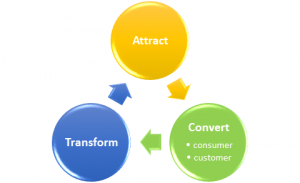Generally speaking, lawyers tend to be slow to adopt new technologies. Social media are no exception: many lawyers still, and incorrectly, assume there are no real benefits to using social media. In previous articles, we discovered that the new legal consumer behaves differently, and operates in an online paradigm. A three-pronged approach was suggested to attract the new legal consumers. The keywords were: cultivate / offer / engage. Many websites focus mainly on the offer aspect. Social media play an important role in the both the cultivate and engage aspects.
In order to elaborate on this, it is good to pay some attention first to social media marketing in general. You probably already have a website, but somehow the percentage of visitors to your website that results in actual new customers is rather low. That is because the old ways of turning visitors into customers are not the most effective in an online paradigm. In the new online marketplace, everybody offering products or services must realise that they also are publishers, and that potential customers are content consumers. The way to turn website visitors into customers is to turn them into regular content consumers first.
In her book, The Zen of Social Media Marketing: An Easier Way to Build Credibility, Generate Buzz, and Increase Revenue Shama Kabani explains the ACT Methodology for social media marketing: ACT is short for Attract – Convert – Transform.
A stands for Attract. You want to draw attention or stand out. Practically, this means attracting traffic to your website, as well as to your presence on social media. Needless to say, you need to be active on social media, if you want to use them as a channel to attract visitors.
C is for Convert. Conversion happens when you turn a stranger into a consumer or a customer. As mentioned above, there is a difference between the two. By converting a website or social media visitor into a content consumer, you create a relationship with him or her. Over time, this relationship increases the likelihood of that content consumer becoming a customer, provided you present them with quality content. The more is at stake, the longer this may take. This means that you constantly have to work to convert people into consumers and customers. Social Media are a great tool for turning strangers into content consumers.
T stands for Transform. Transformation is when you turn past and present successes into magnetic forces of attraction. In a previous article, we found out that many people looking for a lawyer consider online reviews and testimonials important. Indeed, testimonials and reviews by existing customers help attract and subsequently convert new consumers and costumers. Social Media provide an extra, and important, platform for your existing customers to provide you with the glowing feedback which will help to do so.
As a content provider, you must think of everything you publish online in function of one of the three aspects of the ACT methodology: how does what I put out there help attract, convert or transform? The same applies to the three-pronged approach of cultivating, adapting your offer and engaging with the new legal consumers: each has to be done with the purpose of attracting, converting or transforming.
Social media are very well suited to cultivate the new legal consumers and engage with them. Media like LinkedIn, Facebook, Google+, or Reddit, e.g., are ideal platforms to offer assistance, or to start or take part in discussions. If you want to demonstrate your expertise, a blog on your website is not the only possible way to publish specialized articles. Social media like LinkedIn, Facebook, Google+ also offer the same ability, with the added benefit of reaching a larger audience.
In summary, social media have a role to play in attracting and transforming new consumers and customers, and are crucial in converting strangers into content consumers. They offer a platform to cultivate the new legal consumers and to engage with them.
Sources:
- Shama Kabani, The Zen of Social Media Marketing: An Easier Way to Build Credibility, Generate Buzz, and Increase Revenue, Benbella Books, 2013.
- Nika Kabiri, Sink or swim: How to adapt to the New Legal Consumer, 27 April 2016, avvo.com; go.avvo.com/new-legal-consumer-download
- Stephen Furnari, Understanding the new legal consumer, lawfirmsuites.com/2016/06/understanding-the-new-legal-consumer-infographic/


